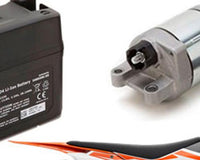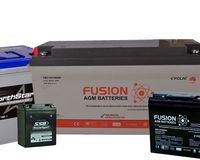Table of Contents
Lead Acid Batteries are the most common type of battery used in solar power systems. They may have a low energy density, but they're still better than the alternative. Lead-acid has moderate efficiency and high maintenance requirements — but you can forget about those expensive costs.
The good news is that this type of battery lasts for years before needing another charge or reinstallation; all at an affordable price point to boot. In addition, one of the best things about lead-acid batteries is that they're used for most rechargeable battery applications, which means there's an extensive security base to ensure safety and convenience.

How do Lead Acid Batteries Work
Lead Acid batteries have changed little since the 1880s although improvements in materials and manufacturing methods continue to bring improvements in energy density, life, and reliability. All lead-acid batteries consist of flat lead plates immersed in a pool of electrolytes. Regular water addition is required for most types of lead-acid batteries although low maintenance types come with excess electrolyte calculated to compensate for water loss during a normal lifetime.
History of Lead Acid Battery
The lead-acid battery was the first form of rechargeable battery to be developed. The idea was originally proposed by a French physicist named Gaston Plante in 1860.
Although another French scientist named Gautherot had discovered that Platinum or Silver wires that had been used to electrolyse saline water produced a current for a short duration, this was never developed into a workable battery.
The first lead-acid cells were made from lead plates. The battery “then” had to be formed by charging it so that one of the plates oxidised. The battery then increased its capacity over successive charge-discharge cycles.
Once the basic lead-acid technology was established, the next major development involved addressing the problem that existed of water loss and the electrolyte drying up. Batteries needed period topping up with distilled water in order to ensure their operation. This was overcome by inserting a valve into the battery. These valve regulated acid batteries, VRLA by utilising an oxygen recombination mechanism. The gases produced inside VRLA battery are made to recombine inside and the battery which is sealed under normal conditions.
Advantages of Using Lead Acid Batteries
1. Cheap
Lead-acid batteries are a fantastic and cost-effective way to store energy. They're cheap, environmentally friendly, reliable with plenty of capacity for short term use as well as long-term storage needs.
2. Powerful
They are a powerful and reliable source of energy. They're used in cars, trucks as well as other vehicles such as motorcycles or tractors that require an engine to be powering it up through its gears - which means these types propel you on your way!

3. Rechargeable
The lead-acid battery is the most common type of rechargeable cell. It has been used for years because it can easily be recharged, allowing you to charge your phone or other electronic devices on the go without worrying about dead batteries.
4. High Power Output Capability
Lead-acid batteries' ability to provide long-lasting strength and durability make them the perfect choice in many applications where you need something with a lot of juice, like an electric car.
Disadvantages of Using Lead Acid Batteries
1. They're Heavy and Bulky
Because of their weight, it makes them difficult to transport. But they have one major edge: a low self-discharge rate which means you can leave them stored for long periods without seriously decreasing their power.
2. Not Suitable for Fast Charging
Lead-acid batteries are not suitable for fast charging and can be dangerous if misused. They have a lifespan of 8 to 10 years, after which they need to be replaced with new ones.
3. Overheating Issues
Overheating is a common issue with lead acid batteries. The reason they overheat, however, should not be ignored as this may result in the destruction or disability of your battery (depending on its size). Caring for these types of power sources requires knowing how much water you need daily until one month before it's due for replacement; keeping them at room temperature during storage time periods between charging sessions - 35 degrees Fahrenheit wasn't too high? Too cold and sulfate crystals begin growing inside causing irreversible damage which can make storing next to impossible without risking serious injury from fumes.
The lead-acid battery is very well established. It has been in use for over 150 years and is currently one of the mainstays of the automotive industry. The lead-acid battery has a high current capability, low cost and it is tolerance to abuse. This makes it ideal for many applications. However, with the move to more environmentally friendly sources of power, electric vehicles now appear to be the future with manufacturers and legislation pointing to the phasing out of the internal combustion engine.
Get the best batteries for your business and professional needs here at Battery Specialists. We’re the largest battery stockists in Australia.
Get in touch with us today for all your battery needs.









